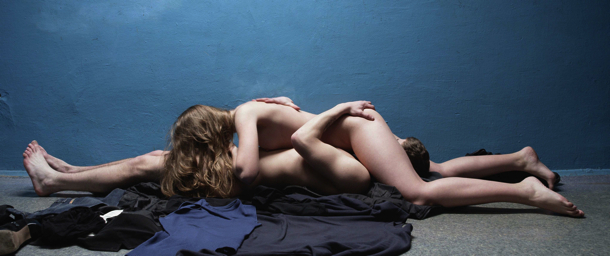




Director/Writer: Myroslav Slaboshpytskiy
Cast: Grigoriy Fesenko, Yana Novikova, Rosa Babiy, Alexander Dsiadevich
Ukraine Drama 132mins
How many single-take sex scenes in cinema today show the pair going at it in multiple positions over an appreciable amount of time? Answer: at least one—that being in Cannes prize-winner THE TRIBE (PLEMYA), the debut feature by palpably talented Ukrainian writer-director Myroslav Slaboshpytskiy, who returns to Locarno Film Festival this year as a jury member overseeing its Pardo di domani competition, having won a prize at the festival in 2012 for his impressive mid-length film NUCLEAR WASTE.
Coming back to this sex scene though: teenagers Sergey (Grigory Fesenko) and Anya (Yana Novikova) make love on the cold, hard floor of a boiler room in the boarding school at which they both reside. It’s an unsentimental, rather passionless scene that ends with unexpected post-coital tenderness—Anya kissing Sergey with previously elusive sincerity—all the more so considering it begun with a monetary transaction. Why money? Because Sergey has for the first time just escorted Anya and her roommate Svetka (Rosa Babiy) to a nearby overnight parking lot for long-distance truck drivers, who routinely pay to have sex with the two teenagers. Witnessing the ease with which Anya accepts this scenario, Sergey fancies a go himself, and duly pays up.
There’s a twist. The whole scene, like the whole film, is dialogue-free: Sergey and Anya are both deaf mutes, attending a specialised school where new arrival Sergey has quickly fallen in with the wrong crowd—the same lot who, under the influence of their woodwork teacher (Alexander Panivan), mug innocent people for their booze and money at night, who illegally sell trashy souvenirs on local train services, and who are making money from Anya and Svetka’s exploits.
Exploits? Make that exploitation. THE TRIBE is all about the various strategies by which people are both impacting and impacted upon, how they adapt to and affect their social environment—whether through an organic chameleonism or something less subtle, such as intimidation and violence. Hierarchies are unavoidable. Upon arrival, Sergey’s lonely procession through the school canteen culminates in a pupil with Down Syndrome stealing his lunch, only for the head bully to spit on the burger and summon Sergey outside to take him under his wing. Soon after, Sergey must undergo an initiation, which entails him having to fight off his new friends—which he does so with surprising ease.
Communication goes entirely unsubtitled; to anyone unfamiliar with sign language, the literal content of the film’s many conversations will be a struggle. This is the point, of course: compare the aforementioned school canteen scene with similar examples in, say, Gus Van Sant’s ELEPHANT (2003) to realise the voluminous texture and timbre given by a wildtrack naturally composed of an indiscriminate sea of vocal chords. Consequently, this is an intensely and interpretably visual film, effortlessly blending immobile establishing shots with elegant Steadicam movements to simultaneously echo the characters’ own sensorial limitations and subsequent negotiation of the world through other, heightened gestures. Working with cinematographer (and editor) Valentyn Vasyanovych, Slaboshpytskiy opts for long-takes and, frequently, wide compositions in order to allow his performers full expressive range.
Soundlessness begets ambiguity. Without the benefit of sonic cues, otherwise disturbing incidents have a deadpan absurdity. Sergey’s initiation sequence begins with its participants warming up with comical shadow sparring and daft shoulder-nudges, and the fight itself, unfolding without edits, has a kind of emotionally constipated choreography. It’s as if we’re watching, out of earshot, the dance floor at a silent disco. There’s even something morbidly funny in the harmless way in which an otherwise vicious attack on someone walking home with their groceries one evening is rendered like a cartoon—or in that scene when one character is run over by a slowly reversing lorry as he smokes a cigarette completely unable to hear it approaching.
Obviously, to feel morbid funniness in a scene is not to claim there is an easy, go-to emotional response to it. Dragged into such tonal registers, we ourselves are tricked. And, as THE TRIBE continues, its silences seem to become more protracted, its tracking shots more suggestive, its scenes grimmer and darker. It takes a certain sort of director to alternate between strangely sweet moments, such as that in which a creepy official shares his innocent holiday photos with two teens he’s presumably paying for sex, and scenes of unthinkable physical and mental stress—such as that horrible scene in which Anya pays for and endures a backstreet abortion.
Just as the consequences of the latter scene will take time to register for Anya, one realises with belated horror—and, yes, excitement—that the violent underpinnings of THE TRIBE’s earlier scenes were glaring clues all along, setting in motion a sequence of events that can only end in the most hilariously heinous way possible. ©MICHAEL PATTISON
THE TRIBE IS ON BfiPlayer | SUTHERLAND AWARD WINNER – LONDON FILM FESTIVAL